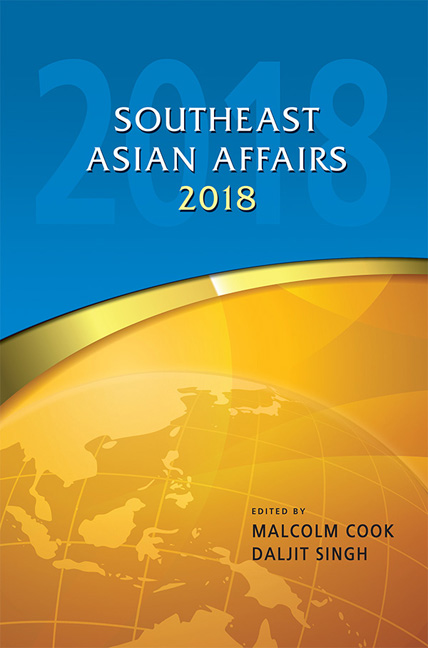Book contents
- Frontmatter
- Contents
- Introduction
- Acknowledgements
- THE REGION
- BRUNEI DARUSSALAM
- CAMBODIA
- INDONESIA
- LAOS
- MALAYSIA
- MYANMAR
- THE PHILIPPINES
- SINGAPORE
- THAILAND
- Thailand in 2017: Stability without Certainties
- Haunted Past, Uncertain Future: The Fragile Transition to Military-Guided Semi-Authoritarianism in Thailand
- Thailand's Southern Insurgency in 2017: Running in Place
- TIMOR-LESTE
- VIETNAM
Thailand's Southern Insurgency in 2017: Running in Place
from THAILAND
Published online by Cambridge University Press: 08 June 2019
- Frontmatter
- Contents
- Introduction
- Acknowledgements
- THE REGION
- BRUNEI DARUSSALAM
- CAMBODIA
- INDONESIA
- LAOS
- MALAYSIA
- MYANMAR
- THE PHILIPPINES
- SINGAPORE
- THAILAND
- Thailand in 2017: Stability without Certainties
- Haunted Past, Uncertain Future: The Fragile Transition to Military-Guided Semi-Authoritarianism in Thailand
- Thailand's Southern Insurgency in 2017: Running in Place
- TIMOR-LESTE
- VIETNAM
Summary
The year 2017 marked the fourteenth year of a renewed insurgency that has roots in the post–Second World War wave of national-liberation movements, a legacy of Siam's annexation of the Patani region at the start of the twentieth century. Beginning in the 1960s, and waged at a low level through the 1970s to the 1990s, the insurgency re-emerged with unprecedented intensity at the start of the new millennium. Malay nationalist groups cast their fight as one for liberation from Thai rule and for national self-determination. The main militant group, Barisan Revolusi Nasional Melayu–Patani (Patani–Malay National Liberation Front; BRN), founded in 1960, built a clandestine network of cells in the southernmost provinces during the 1990s. Since the beginning of 2004, militants have continually staged ambushes, bombings and assassinations, but at a slowing pace over the past several years. Deep South Watch, an NGO that monitors violence in the region, estimates that almost seven thousand people have been killed. Violence has declined over the past several years, and in 2017 reached its lowest point since 2004; the insurgency claimed 235 lives, compared to 309 in 2016 and a peak of 892 in 2007.
Violence has been largely confined to the provinces of Pattani, Narathiwat and Yala and four southeastern districts of Songkhla: Chana, Nathawi, Saba Yoi and Thepa. This region of approximately 13,500 square kilometres is home to two million Thai citizens. Roughly eighty-four per cent of the population are Muslims who speak Malay as their first language, the remainder almost entirely Thai or Sino-Thai Buddhists. In contrast to the previous year, there were no insurgent attacks outside of the southernmost provinces in 2017.
Peace Dialogue
Thailand's military junta, the National Council for Peace and Order (NCPO), took power in a May 2014 coup. The military had been hostile to a peace dialogue process with BRN initiated by the Yingluck Shinawatra government in February 2013. Known as the Kuala Lumpur Process and facilitated by Malaysia, it collapsed after just three plenary meetings, but it marked the first time that a Thai government had publicly committed to negotiating a settlement with those who had taken up arms against the state. In spite of the army's scepticism of the earlier dialogue, the NCPO turned to reviving a dialogue with militants in late 2014, six months after seizing power.
- Type
- Chapter
- Information
- Southeast Asian Affairs 2018 , pp. 377 - 388Publisher: ISEAS–Yusof Ishak InstitutePrint publication year: 2018



